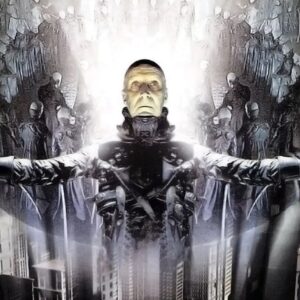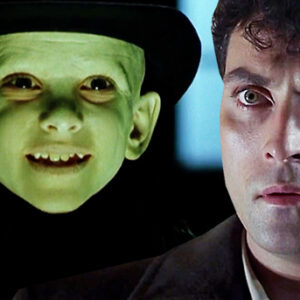Last Updated on June 24, 2024
Director Alex Proyas’s Dark City (you can watch the Dark City theatrical cut HERE, and the director’s cut at THIS LINK), which blends sci-fi and film noir much like Blade Runner did, wasn’t a hit when it was released to theatres in 1998, but it did receive a lot of positive attention from critics, with Roger Ebert even going so far as to name it the best film of the year. So it’s interesting that the theatrical cut was a compromised version of Proyas’s vision, the result of the film being whittled down after it received a weak response from a test screening audience. In this video, we’re going to dig into the making, editing, and re-editing of Dark City to find out What the F*ck Happened to This Horror Movie.
Dark City tells the story of a man named John Murdoch, played by Rufus Sewell, who wakes up in a hotel room to find that he has no memory of anything that happened to him before he woke up. He doesn’t know who he is, but he knows he doesn’t want to catch the blame for the slashed-up corpse beside his bed. Murdoch’s quest to solve the mystery of his own identity and find out why he’s waking up next to dead bodies will eventually lead him to discover that the shapeshifting city of endless night that he’s living in is under the control of alien beings called the Strangers, and that he has the same reality-bending ability these Strangers have. An ability called Tuning.
“First there was darkness. Then came the Strangers.” That’s a line from Dark City, but it’s also a fitting description of how the concept of the film first occurred to Alex Proyas. It all started with a dream he had about the Strangers, the group of trenchcoat-wearing characters the filmmaker described as “strange, bald-looking men with an ethereal, androgynous quality”. Basically, they resembled Riff Raff from The Rocky Horror Picture Show, which is why Richard O’Brien was cast as the most prominent Stranger in the film. Inspired by his dream, Proyas began writing the first draft of Dark City in 1990, but the story would go through some major changes on the way to production.
Wanting to blend a hard-boiled detective story with the science fiction genre, Proyas centered his first draft on a detective investigating a murder mystery, and over the course of the investigation the detective would realize that nothing about the case – or the world around him – made sense. By the end of the script, the mystery became so overwhelming that the detective went insane. That first draft sounds like it could almost work as a prequel to the final version of Dark City, because there is a detective who lost his mind while on the job in the film, but he has already gone crazy and been taken off the case before we’re introduced to him. Played by Colin Friels, he’s a side character named Walenski and he has some memorable interactions with William Hurt’s Inspector Frank Bumstead, the detective who replaced him on the murder investigation, and with the prime suspect in the case, Murdoch.
A music video director who made his feature debut with the sci-fi adventure Spirits of the Air, Gremlins of the Clouds, in 1987, Proyas is best known for his second feature, the 1994 comic book adaptation The Crow. He found further inspiration for Dark City while he was filming The Crow, watching crew members work with the sets constructed to bring his vision of Detroit to the screen. This is when he had the idea for the imagery of buildings growing from the ground up and changing shapes in the world of Dark City.
Despite the success of The Crow, Proyas had trouble finding a suitable home for Dark City, moving it from studio to studio in a search for the one that would give him the most creative freedom. It ended up at New Line Cinema, a studio that had some of its greatest successes by taking a chance on projects other studios didn’t have faith in. At this point, New Line was known as “The House That Freddy Built” because it had paid off so well when they took a chance on Wes Craven’s A Nightmare on Elm Street. A few years later, they would give Peter Jackson the opportunity to make the Lord of the Rings trilogy. They were willing to let Proyas make the film he wanted to make, and even provided a budget that the filmmaker would later admit was probably higher than the story merited.
As Dark City moved toward production at New Line, the story began to evolve. Lem Dobbs was hired to do a pass on the script, and while he probably got the job because of the work he did with Steven Soderbergh on Kafka, he should have been getting buried in job offers due to the fact that he wrote the Gary Busey classic Hider in the House. The Dobbs draft brought the story closer to what we see in the finished film, shifting the focus from the investigator to the murder suspect. When New Line increased the budget, a decision they might have regretted later on, David S. Goyer was brought in to add some bigger action and effects sequences into the story Proyas and Dobbs had written. Today, Goyer is very well known for working on high profile projects like Christopher Nolan’s Dark Knight trilogy, Man of Steel, and Batman v. Superman, but at the time he had been building up his career working on lower budgeted fare like Kickboxer 2 and Demonic Toys, as well as the Jean-Claude Van Damme movie Death Warrant. Proyas chose him to work on Dark City after reading his script for Blade, which New Line also released in 1998.
With the script ready, Proyas assembled his cast. In addition to the actors already mentioned, notable cast members include Jennifer Connelly as Murdoch’s lounge singer wife Emma, Bruce Spence of the Mad Max franchise as one of the Strangers, Melissa George in her big screen debut as a prostitute who crosses paths with Murdoch, and Kiefer Sutherland, who gives a show-stealing, oddball performance as Doctor Daniel Schreber, a human who is in league with the Strangers and therefore one of the only people in the city who knows exactly what’s going on. Schreber is a character who was originally envisioned as being an older man; in fact, Proyas considered William Hurt for the role before he cast Hurt as Bumstead, and when Sutherland received the script he thought there had been a mistake, as the role of Schreber seemed to be more fitting for his father, Donald Sutherland.
Schreber knows that the aliens in control, which look like demonic jellyfish and are piloting human corpses – every Stranger is actually the re-animated body of a deceased person – are a dying race, and they’re conducting this citywide experiment on people in hopes of finding a way to save themselves. They’re not doing this on Earth, either. All of the people in the city have been abducted from Earth and dropped into this fake metropolis, which happens to be on some kind of ship that’s moving through space. That’s similar to how Proyas took his cast and dropped them into a world that was meticulously crafted by production designers George Liddle and Patrick Tatopoulos, alongside art directors Richard Hobbs and Michelle McGahey. With brief exceptions, Dark City was not shot in exterior locations, the entire city was built on a set. The place looks incredible, and even if the Academy didn’t agree with Roger Ebert’s opinion of the film enough to nominate it for Best Picture, they should have at least given the production designers and art directors a nod that year.
Dark City was shot in Proyas’s home country of Australia, and New Line let him do his thing. Trouble didn’t enter the picture until Proyas had cut the film together and New Line held a test screening. This screening wasn’t a disaster, there weren’t any walkouts, but Proyas could tell that some members of the audience had checked out of the story well before the end. He said there was a lot of shuffling and moving around in the audience; viewers were intrigued enough that they wanted to see how it all turned out, but they were anxious for it to be over. Checking the scores and comments after the screening, New Line found that the audience opinion was split – which was bad news as far as they were concerned, because they had sunk something in the range of thirty to forty million into this project, and they wanted it to appeal to the widest audience possible. Proyas wasn’t surprised to find that Dark City wasn’t for everybody, and didn’t want to alter his film to try to draw in viewers who might not appreciate his director’s cut. But New Line felt some editing needed to be done, and an executive actually told Proyas, “You’ve got to dumb it down.”
The process of dumbing Dark City down involved trimming a lot of scenes and rearranging some moments, but the biggest change that was made was the addition of an opening narration delivered by Sutherland’s Doctor Schreber. The theatrical cut doesn’t give Proyas any chance to lure the viewer in with a mystery and then gradually reveal the facts to them. Viewers who went to see Dark City during its initial run were greeted with a scene in which Schreber tells the audience what’s going on in this city in the very first minutes of the film. This narration is based on dialogue that wasn’t supposed to be spoken until more than eighty minutes into the movie. Every night at midnight, the Strangers put everyone in the city to sleep so they can manipulate the cityscape and, with Schreber’s help, swap the memories of residents, changing people into different characters with different lives. Schreber’s narration is immediately followed by shots of people around the city falling asleep at midnight, something Proyas didn’t intend for us to see until almost forty minutes into the movie.
Re-editing the film and making it easier for the general audience to understand didn’t result in great financial success. Dark City quickly gained a cult following, but it only pulled in twenty-seven million at the global box office. The film never ranked higher than number four domestically, largely overlooked in cinemas while Titanic was having its seventeen week reign at number one. Proyas felt that New Line might as well have just stuck with his director’s cut, as he figured it would have made as much, if not more, than the theatrical cut did.
Although Dark City got a special edition DVD release in 1998, with Ebert proving his appreciation for the film by recording a full-length audio commentary for it, the director’s cut was not included on the disc. Fans didn’t have the chance to see Proyas’s cut of the film until 2008, when it was included on tenth anniversary DVD and Blu-ray releases.
The director’s cut has a running time eleven minutes longer than the theatrical cut, boosting it from one hundred minutes to one hundred and eleven minutes. Most of those eleven minutes are achieved through scenes being slightly extended with additional shots, and dialogue exchanges containing some extra lines. The film’s spiral motif gets a bit more focus, and some scenes are moved around in the timeline, like that early sequence of people falling asleep around the city occurring much deeper into the film. Proyas also took the opportunity to update the special effects used to show Murdoch’s Tuning ability, as he felt the Tuning effect in the theatrical cut was too “heavy handed”. It’s a very minor tweak.
Most importantly, the opening narration from Schreber has been removed. Sure, the movie had worked fine with that narration in there, but giving an information dump like that up front just wasn’t a good way to tell the story. In the director’s cut, the viewer receives that information as the story plays out, learning what’s going on as Murdoch does. Which is how it should be.
The differences between the theatrical cut and the director’s cut don’t sound that huge when you break them down, but as Proyas says, all the small changes that were made for his cut have a cumulative effect of providing the audience a richer viewing experience. The fact that the director’s cut doesn’t have Schreber spilling the beans in the very first scene makes it the preferred version of the film right away.
Dark City was always awesome, even in its compromised form, but the director’s cut is an improvement. It’s great that Proyas was finally able to get it out into the world, and now viewers have the chance to watch the version of Dark City they should have been able to see in 1998.
Some previous episodes of the series can be seen below, and more can be found on our JoBlo Horror Videos YouTube channel!




















Follow the JOBLO MOVIE NETWORK
Follow us on YOUTUBE
Follow ARROW IN THE HEAD
Follow AITH on YOUTUBE